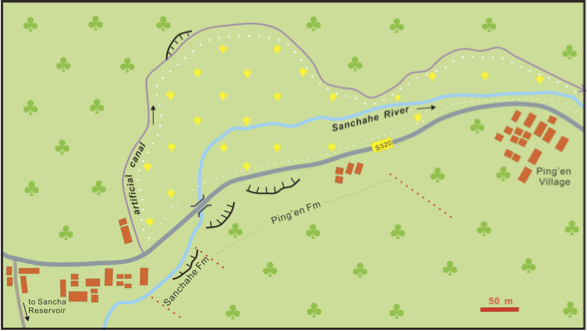Pingen Fm
Type Locality and Naming
The type section is located at east of Sanchahe Reservoir of Ping’en Tun, Nachi Village in Napo County, Guangxi (23o16’ 55’’N - 105o 57’ 25’’E), along the south side of the County Road No. S320. It was named by Xian Siyuan et al. in 1980.
Synonym: Ping'en Fm
[Figure Map showing the location of the stratotype of Ping’en Formation in the south side of County Road No. S320 at Ping’en Village, Napo County of Guangxi.]
Lithology and Thickness
Limestone. The formation is represented by a set of thin-bedded carbonates and carbonate-cherty deposits. It is 192 m thick in the type section. It is easily distinguished from overlying and underlying formations by: (1). The rocks are mainly composed of homogeneous thin or medium-bedded well-bedded micritic limestones intercalated with centimetric-bedded or lenticular cherts, mudstones and black shales. The thickness of a single bed is about less than 10 cm in average. Medium-bedded limestones seem to increase in the upper part of the formation. (2). Sedimentary structures are mainly laminated and horizontal bedding, 1 and 3 mm thick, commonly distributed in the base or top of each bed. Occasional calcareous turbidites, sliding structure, and wash-bedding can be observed. And (3). The fossils such as pelagic ammonoids, dacryoconarids and conodonts are commonly seen and mixed with few benthic corals and brachiopods.
[Figure Outcrops of Ping’en Formation in the type locality of Ping’en Village. A- A cliff by the roadside of County Road no. S320 showing the general view of Ping’en Formation. B-The details of the thin-bedded limestone, 5-6 cm thick in average of a single bed with fine laminations. C-Middle part of the formation. D-Alternating thin-bedded limestone and siliceous beds (red arrow). E-Small sliding in the thin-bedded limestones. F-Black shales may represent event deposits. Length of hammer 28 cm. ]
Relationships and Distribution
Lower contact
The lower contact of the Formation is placed at the appearance of thin-bedded limestone above the nodular limestone of Sanchahe Fm.
Upper contact
It has conformable contact with the overlying siliceous rocks of Liujiang Fm.
Regional extent
It is widely distributed in southwest Guangxi and southeast Yunnan. Regionally, the lithology is relatively uniform, only containing phosphates in the lower part and intercalated with siliceous rocks in the upper part in Congzuo, Daxin, Debao; and with black shale in the lower part in Heshan of Longlin and Nabo.
The Formation is correlated with the middle and upper parts of Daliantang Fm of SE Yunnan, which is restrictively composed of the thin-bedded limestone.
GeoJSON
Fossils
Lower part yields Ammonoids Anetoceras sp., Erbenoceras sp.; Dacryoconarids Nowakia barrandei N. elegans; Conodonts Polygnathus perbonus, P. gronbergi, P. inversus, etc. Upper part contains Dacryoconarids Nowakia cancellata, N. rechteri, and N. cf. holynensis zone, and Conodonts of Polygnathus inversus, P. laticostatus, P. serotinus, respectively occurring in various beds.
Age
Depositional setting
Deep-water. Wide range of lithology reflects different sedimentary environments. The pelagic faunas and well-developed planar laminated limestones are in accord with “deep shelf” (Flügel, 2004) deposited well below storm-wave base of a deep-water basin environment and in some horizons the sliding are observed which would suggest a slop facies. The black shale was interpreted as deep water with relatively low to anoxic oxygen conditions.
Additional Information

